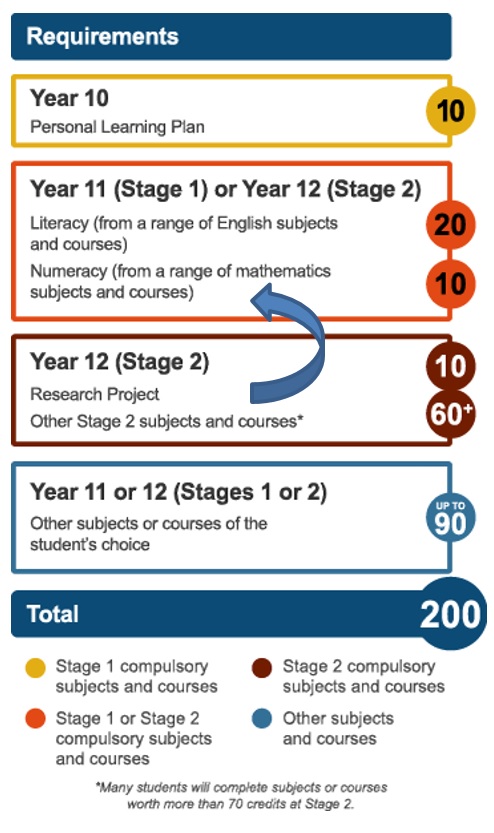Senior School SACE (Year 11-12)
If you are new to the SACE, please take the time to read the information below to assist you in making your course choices.
If you are ready to proceed, please click the button to read the course information.
SOUTH AUSTRALIAN CERTIFICATE OF EDUCATION (SACE)
The SACE is made up of two parts:
- Stage 1 (which most students do in Year 11) and
- Stage 2 (which most students do in Year 12)
Each subject or course that students successfully complete earns ‘credits’ towards the SACE. 10 credits equate to one semester of study in a subject, and 20 credits equate to a full-year subject. Student work will be assessed using an A to E grading system in Stage 1 and an A+ to E- grading system in Stage 2.
To gain the SACE, students need to achieve 200 credits. The compulsory subjects make up 50 credits:
- 10 credits for the Personal Learning Plan (PLP) in Year 10
- 10 credits for the Personal Learning Plan (PLP) in Year 10
- 20 credits chosen from a range of English subjects (Stage 1 or Stage 2) – Literacy requirement
- 10 credits chosen from a range of Mathematics subjects (Stage 1 or Stage 2) – Numeracy requirement
- 10 credits for the Research Project (Stage 2) in Year 11
Students will also need to successfully complete at least 60 credits from Stage 2 subjects. Students can choose these subjects, but they have to be worth at least 60 credits in total.
The remaining 90 credits can be gained through additional Stage 1 or Stage 2 subjects or SACE Board-recognised courses (such as VET or community learning). Students can choose the subjects or courses that they study to gain the remaining 90 credits.
To gain the SACE, students need to achieve:
- a C grade or better in the compulsory Stage 1 subjects
- a C- grade or better in the compulsory 70 credits of Stage 2 subject, including 10 credits for the Research Project.

VET AND SACE
Vocational Education and Training (VET) refers to education and training that focuses on delivering skills and knowledge required for specific industries. Students may access VET in a number of ways including: through in-school delivery at a Registered Training Organisation (RTO). TAFE is one example of a RTO or through a School-based Apprenticeship or Traineeship.
The SACE provides significant flexibility for students to study VET competencies as part of their senior schooling. Student may earn up to 150 credits, of the 200 credits required to complete the SACE, through recognised Vocational Education and Training courses. For more details about VET courses please refer to the relevant sections in this course book (may be just a link). Interested students need to make an appointment with our VET Coordinator to discuss these possibilities. More information can be found at the SACE Website.
COMMUNITY LEARNING
Students are able to earn SACE credits for community learning in two ways – Community-developed Programs and Self-directed Community Learning. Community-developed Programs include, for example, the Australian Music Examinations Board, the Duke of Edinburgh’s Award and the SA Country Fire Service.
Self-directed Community Learning is gained through informal community activities such as coaching a sports team, being the primary carer of a family member, or leading an environmental project in the community. Students will need to provide evidence of their learning for assessment so that the SACE Board can recognize these other kinds of community learning. More information can be found at the SACE Website.
SACE information for students and families.
Students Online helps students explore different subject and course combinations, and keep track of their progress in the SACE. Students will need their student registration number and PIN to log in.
SPECIAL PROVISIONS
The SACE Board recognises that students affected by misadventure, or personal circumstances that are beyond their control, or the control of their schools, may require reasonable adjustments in curriculum and assessment to participate in programs, and associated assessments, on the same basis as other students. Schools are responsible for identifying and implementing reasonable adjustments that can be managed within the school context. The SACE Board is responsible for considering and approving requests for reasonable adjustments for eligible students in external assessments at Stage 2 that affect SACE Board processes. More information can be found at the SACE Website.
UNIVERSITY AND TAFE SA ENTRY:
Gaining the SACE is the main method used by South Australian students to gain admission into university and TAFE courses. Students who complete the SACE are eligible for university entry, provided they meet certain requirements. TAFE SA recognises the SACE as meeting the Course Admission Requirements (CAR) for most of its courses. It also considers a variety of other qualifications and experiences in its entry and selection processes. Applications for university and TAFE courses are handled by the South Australian Tertiary Admissions Centre (SATAC). Selection into university courses is based on both eligibility and rank. Eligibility allows the student to be considered for selection; rank determines whether the student is competitive enough to be selected.
Eligibility
To be eligible for selection into a South Australian university course /program the student must:
- Qualify for the SACE
- Obtain an Australian Tertiary Admission Rank (ATAR)
- Meet prerequisite subject requirements for the course/program.
Competitiveness
The student’s competitiveness in relation to other applicants is based on his/her ATAR which is a rank given to students on a range from 0 to 99.95. The ATAR is calculated from the university aggregate. To obtain a university aggregate and an ATAR, the student must:
- Comply with the rules regarding precluded combinations (significant overlap in content)
- Comply with the rules regarding counting restrictions (limit to the number of credits in a specific subject area)
- Complete at least 90 credits of study in Tertiary Admissions Subjects (TAS) and Recognised Studies at Stage 2
- Of the 90 credits of study a minimum of 60 credits of study must be from 20 credit TAS
Note: Normally 10 credit subjects do not count towards this requirement but some 10 credit subjects in the same area, when studied in pairs, can substitute for a 20 credit subject. These are called valid pairs.
The university aggregate is calculated from the student’s best scaled scores from three 20 credit TAS plus the best outcome from the flexible option, which is the best credits of scaled scores or scaled score equivalents from
- the scaled score of a 20 credit TAS
- half the scaled score of one or more 20 credit TAS
- the scaled score of one or more 10 credit TAS
- scaled score equivalents for Recognised Studies to the value of 10 or the maximum of 20 credits
- subject to precluded combination and counting restriction rules.
Prerequisite
Some university courses/ programs require students to have completed one or more specific SACE stage 2 Tertiary Admission Subject (TAS) in which a student must obtain a minimum grade of C- or better in order to be eligible for selection into the course/program for which the prerequisite is nominated.
Assumed knowledge
Some university courses/ programs recommend that commencing students have background knowledge in a SACE Stage 1 or Stage 2 subject or an identified skill which is expected to enhance a student’s understanding of the content of a given tertiary course/ program. Assumed knowledge is not compulsory and is not used in the selection process for entry to university courses/programs.
MORE TERTIARY ENTRY INFORMATION:
The IBMYP has eight areas of study which align with those of the Australian Curriculum and the current South Australian Department For Education (DFE) requirements.







